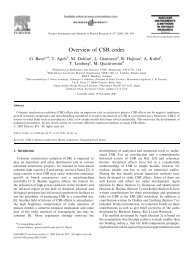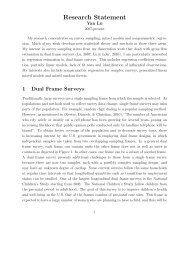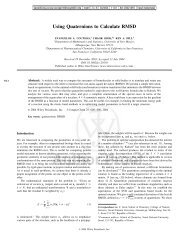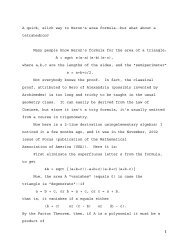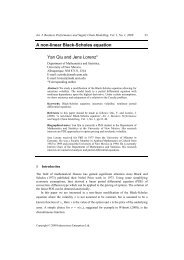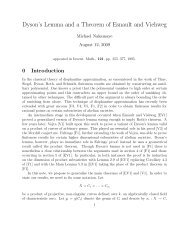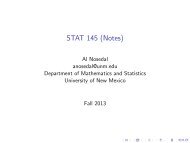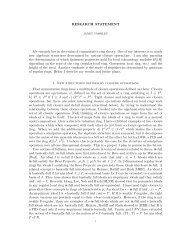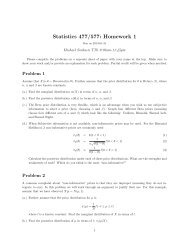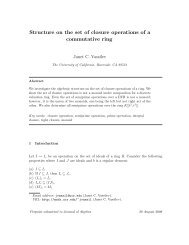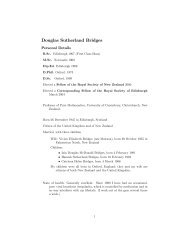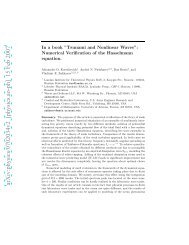OEO Office of Equal Opportunity - Department of Mathematics and ...
OEO Office of Equal Opportunity - Department of Mathematics and ...
OEO Office of Equal Opportunity - Department of Mathematics and ...
Create successful ePaper yourself
Turn your PDF publications into a flip-book with our unique Google optimized e-Paper software.
HISTORY 219<br />
428./628. Women, War <strong>and</strong> Revolution. (3) Slaughter<br />
(Also <strong>of</strong>fered as WMST 428.) Study <strong>of</strong> women’s participation<br />
in wars <strong>and</strong> revolutions, <strong>and</strong> discussion <strong>of</strong> the social impact <strong>of</strong><br />
these events which <strong>of</strong>ten alters women’s status, experience<br />
<strong>and</strong> expectations. Typical approach using global examples<br />
<strong>and</strong> case studies.<br />
V. United States History<br />
300./500. Studies in History. (1-3, no limit) ∆<br />
Will vary from instructor to instructor, but will be an in-depth<br />
analysis <strong>of</strong> specific historical problems. For course content,<br />
consult Schedule <strong>of</strong> Classes.<br />
330./530. The American Colonies, 1607–1763. (3)<br />
Yazawa<br />
The settlement <strong>of</strong> English America. The transference <strong>of</strong> institutions<br />
<strong>and</strong> attitudes from Britain, Europe <strong>and</strong> Africa to North<br />
America <strong>and</strong> what happened to them when they encountered<br />
the new environment <strong>and</strong> the native population.<br />
331./531. The American Revolution, 1763–1789. (3)<br />
Yazawa<br />
The separation <strong>of</strong> British America from the mother country:<br />
why it was undertaken, how it was achieved, what its significance<br />
was. The effort to gather a scattered <strong>and</strong> diverse<br />
people under one constitutional government.<br />
332./532. Age <strong>of</strong> Washington <strong>and</strong> Jefferson. (3) Yazawa<br />
Study <strong>of</strong> the impact <strong>of</strong> the American Revolution on the<br />
post-war society, the creation <strong>of</strong> the new nation, crisis <strong>of</strong><br />
the 1790s, origin <strong>of</strong> modern political parties, Jeffersonian<br />
America, the War <strong>of</strong> 1812 <strong>and</strong> the movement westward.<br />
333./533. Age <strong>of</strong> Jackson. (3)<br />
The United States from 1815 to 1848, emphasizing economic<br />
growth, social transformation, westward expansion, political<br />
democratization, nationalism <strong>and</strong> sectionalism, <strong>and</strong> the rise<br />
<strong>of</strong> the slavery controversy.<br />
334./534. The Civil War Era. (3)<br />
The United States from 1848 to 1868. Topics covered include<br />
slavery, anti-slavery <strong>and</strong> the coming <strong>of</strong> the Civil War; social,<br />
political <strong>and</strong> economic aspects <strong>of</strong> the war; emancipation <strong>and</strong><br />
Reconstruction.<br />
336./536. Twentieth Century America 1920–1960. (3)<br />
Americans debate the role <strong>of</strong> government, the meaning <strong>of</strong><br />
social justice <strong>and</strong> their role in the world as they forge the<br />
New Deal at home <strong>and</strong> fight fascism <strong>and</strong> then communism<br />
abroad.<br />
337./537. Twentieth Century America, 1960–Present. (3)<br />
From JFK/LBJ liberalism to Reagan/Gingrich conservatism;<br />
the civil rights revolution <strong>and</strong> its backlash; from Vietnam to<br />
post-Cold War internationalism; democracy in the information<br />
age.<br />
338./538. The United States in the World War II Era. (3)<br />
Szasz<br />
The Era <strong>of</strong> World War II from the mid 1930s to the mid 1950s,<br />
with a focus on the social, political, economic, cultural, military<br />
<strong>and</strong> diplomatic aspects <strong>of</strong> the conflict.<br />
339./539. Vietnam War Era. (3) Hutton<br />
This history <strong>of</strong> the Vietnam War era covers the origins <strong>of</strong> the<br />
conflict, the nature <strong>of</strong> the war, the home front reaction <strong>and</strong> the<br />
political, military <strong>and</strong> social consequences.<br />
340./540. U.S. Foreign Relations to 1900. (3) Pugach<br />
Survey <strong>and</strong> analysis <strong>of</strong> U.S. foreign relations from independence<br />
to 1900.<br />
342./542. Constitutional History <strong>of</strong> the United States to<br />
1877. (3) Yazawa<br />
The American Constitution from English origins through the<br />
Civil War <strong>and</strong> Reconstruction. The continuing effort to fashion<br />
a frame <strong>of</strong> government broad enough to embrace diverse<br />
peoples <strong>of</strong> different races, religious, national origins <strong>and</strong><br />
value systems.<br />
343./543. Constitutional History <strong>of</strong> the United States<br />
since 1877. (3) Yazawa<br />
Sequel to 342. A century-long struggle to resolve the conflicting<br />
liberties <strong>of</strong> the people <strong>and</strong> requirements <strong>of</strong> an ordered<br />
society. Examination <strong>of</strong> the occasional collisions <strong>of</strong> the cherished<br />
rights <strong>of</strong> property <strong>and</strong> personal freedom.<br />
344./544. U.S. Women to 1865. (3) Scharff<br />
This course introduces students to the history <strong>of</strong> American<br />
women’s roles, status <strong>and</strong> ideas before 1865.<br />
345./545. U.S. Women since 1865. (3) Scharff<br />
This course introduces students to the history <strong>of</strong> American<br />
women’s roles, status <strong>and</strong> ideas since 1865.<br />
346./546. Native America to 1850. (3) Connell-Szasz<br />
(Also <strong>of</strong>fered as NAS 346.) This course will cover American<br />
Indian/Alaska Native history to 1850.<br />
347./547. Native America, 1850–1940. (3) Connell-Szasz<br />
(Also <strong>of</strong>fered as NAS 347.) The course will cover American<br />
Indian/Alaska Native history from 1850 to 1940.<br />
348./548. Native America Post-1940. (3) Connell-Szasz<br />
(Also <strong>of</strong>fered as NAS 342.) Course will address issues that<br />
Native Americans have dealt with from World War II to the<br />
early 21st century, including termination, urbanization, Red<br />
Power, gaming <strong>and</strong> self-determination.<br />
349./549. Military History <strong>of</strong> the United States to 1900.<br />
(3) Hutton<br />
Survey <strong>of</strong> U.S. military <strong>and</strong> naval history from colonial times<br />
to 1900, with emphasis upon technological, managerial<br />
<strong>and</strong> political developments that have affected the armed<br />
services.<br />
350./550. Modern U.S. Military History, 1900 to Present.<br />
(3) Hutton<br />
A survey <strong>of</strong> the origins <strong>and</strong> development <strong>of</strong> American military<br />
institutions, traditions <strong>and</strong> practices <strong>of</strong> the 20th century.<br />
Attention to WWI, WWII <strong>and</strong> the Vietnam war, technological<br />
advances <strong>and</strong> institutional history will be given.<br />
351./551. History <strong>of</strong> Sport. (3) Sanabria<br />
This course <strong>of</strong>fers an interdisciplinary exploration <strong>of</strong> the history<br />
<strong>of</strong> sport <strong>and</strong> the relationship between sport <strong>and</strong> societies<br />
in Western Europe, the United States <strong>and</strong> their colonies from<br />
Antiquity through modern times.<br />
430./630. The Old South. (3)<br />
The South from the beginning <strong>of</strong> colonization to the outbreak<br />
<strong>of</strong> the Civil War. Emphasis on slavery <strong>and</strong> its impact on<br />
southern society.<br />
431./631. Political History <strong>of</strong> the United States. (3)<br />
Study <strong>of</strong> American politics from 1787 to the present. Emphasis<br />
on national politics with special attention to the presidency<br />
<strong>and</strong> changes in the political systems.<br />
432./632. U.S. Social Life <strong>and</strong> Leisure. (3) S<strong>and</strong>oval-<br />
Strausz, Scharff<br />
An inquiry into sociability in the United States from 1820 to<br />
1960. Leading themes include youth <strong>and</strong> working-class culture,<br />
social policing, identity, social life under capitalism, sexuality,<br />
travel, consumer culture <strong>and</strong> the politicization <strong>of</strong> leisure.<br />
ARTS AND<br />
SCIENCES<br />
341./541. U.S. Foreign Relations from 1900. (3) Pugach<br />
Survey <strong>and</strong> analysis <strong>of</strong> U.S. foreign relations in the 20th<br />
century.<br />
433./633. U.S. Environmental History. (3) Scharff, Truett<br />
Examines the environmental transformation <strong>of</strong> the United<br />
States from the colonial era to the present day. Focus on<br />
the ecological consequences <strong>of</strong> colonial encounters; shifting<br />
links between cultures, markets <strong>and</strong> the l<strong>and</strong>; changing ideas<br />
<strong>and</strong> politics <strong>of</strong> nature; <strong>and</strong> the environmental impacts <strong>and</strong><br />
inequalities <strong>of</strong> urban-industrial life.<br />
UNM CATALOG 2006–2007 Symbols, page 611.



